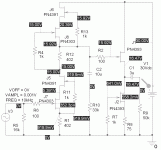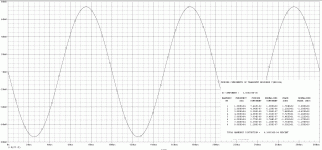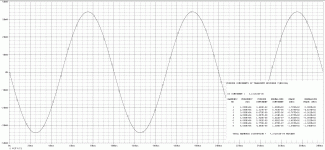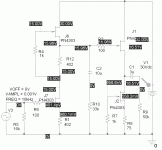Fairchild makes a lot of stuff, but if it's not a JEDEC registered part they play with the specs to their advantage. Noise specs are usually the first to go, and the voltage rating is ofttimes less than the original part.
I have no real motivation to seek out BF-type parts here in the US, unless it's something really special like the BF862. Even that part will wait until I have some means of dealing easily with SOT-23 fets.
I have no real motivation to seek out BF-type parts here in the US, unless it's something really special like the BF862. Even that part will wait until I have some means of dealing easily with SOT-23 fets.
Hi,
how´s about noise?
In all my sims active loads, wether it beeing of the bootstrapped type like the one from Mr. Nikitin or SRPP or additional current-source, like in Wrenchone´s No.3, added considerable noise. So much, that with input voltages and gains typically associated with MC-pickups, the noise voltage levels even came down to less than -75dB (20Hz-20kHz). This is a rather marginal headroom over the vinyl´s inherent noise and compared to the 15 to 20dB better figures for passive loads. Now it´s clear that active loads add more noise than passive ones, but in the cases cited above tha noise penalty seems overly exaggerated. Are those circuits espaecially noise sensitive?
Too bad really, since sims of a cascoded SRPP consisting of pairs of BF862 and a SST4391 showed otherwise fantastic results. Gains of >70dB and THD well below 0.1% with just 20V of supply.
How are Your findings and experiences about that?
jauu
Calvin
how´s about noise?
In all my sims active loads, wether it beeing of the bootstrapped type like the one from Mr. Nikitin or SRPP or additional current-source, like in Wrenchone´s No.3, added considerable noise. So much, that with input voltages and gains typically associated with MC-pickups, the noise voltage levels even came down to less than -75dB (20Hz-20kHz). This is a rather marginal headroom over the vinyl´s inherent noise and compared to the 15 to 20dB better figures for passive loads. Now it´s clear that active loads add more noise than passive ones, but in the cases cited above tha noise penalty seems overly exaggerated. Are those circuits espaecially noise sensitive?
Too bad really, since sims of a cascoded SRPP consisting of pairs of BF862 and a SST4391 showed otherwise fantastic results. Gains of >70dB and THD well below 0.1% with just 20V of supply.
How are Your findings and experiences about that?
jauu
Calvin
My findings with practical cascodes of BJT on top are that there must be high hFE to avoid enough base current and to use low impedance base bias. I use bypassed LEDs there. Not so much sensitive to PSU noise as it may seem on first glance since what they bring in is non correlated and adds mildly. Local psu filtering helps. High value resistors in SRPP will not keep the noise where needed (you set the goal) for an MC. Maybe biasing it with diodes, could work better. Also gate/base stoppers in the lower section must be avoided.
Keep in mind also that the goal in all of these preamps has been to work with MM or high output MC. If I actually break down and get a low output MC cartridge, I'll most likely have to change my thinking (or get/wind a good step-up transformer). I have some supermalloy toroids that might get used for that purpose.
I'm also battling with grounding issues. I live in an old house with a crazy patchwork of electrical wiring. Some is new, some is >50 years old. I get noise and hum in my living room that I don't get in the basement, at work or at Burning Amp. I suspect the reason is that the outlets in my living room aren't grounded. I'm going to have to change that.
I'm also battling with grounding issues. I live in an old house with a crazy patchwork of electrical wiring. Some is new, some is >50 years old. I get noise and hum in my living room that I don't get in the basement, at work or at Burning Amp. I suspect the reason is that the outlets in my living room aren't grounded. I'm going to have to change that.
Hi,
yes, the cascoding transistor should be of high gain types, whereas the ´driving´ transistor of the cascode may give too much gain if it features a high hfe or gm-value. But the cascode itself doesn´t add so much to the noise that it plays a major role in this application. In fact the cascode combination of BF862 and 4391 simmed extremely well with regard to noise and THD. The exploitation of its comparably low capacitance may be more sensitive, especially with MM-pick-Ups.
I think I didn´t correlate the findings in my sims correctly though. Attached are two circuits, one is a cascoded SE-stage feeding into a resistive load and the other is a cascoded SRPP-stage.
The noise problem is obviously not so much due to the active loading as I initially thought. I was tricked by the immense gain (and as such noise-gain) that the stage is capable of. The SRPP has app. 40dB more gain than the cascoded SE-stage, which correlates well with the roughly 40dB higher noise figure. What remains fascinating is that the THD-values nearly equal, consisting mainly of K2. K3 sims in fact much higher with the SRPP circuit, but is still on such a very low value, that its influence on the THD-figure remains negligible.
The gain of the SRPP is extremely high. While the stage may handle a preequalized phono signal up to the midrange it certainly will clip at the HF end. R10 is added to allow for a certain reduction of gain, but a parallel cap will be needed to lowpass-filter (2120Hz-LP) to avoid overdriving the stage.
One could of course reduce the gain a bit by using just one BF82 per cascode instead of a paralled pair, but this wouldn´t affect much on noise figure.
jauu
Calvin
yes, the cascoding transistor should be of high gain types, whereas the ´driving´ transistor of the cascode may give too much gain if it features a high hfe or gm-value. But the cascode itself doesn´t add so much to the noise that it plays a major role in this application. In fact the cascode combination of BF862 and 4391 simmed extremely well with regard to noise and THD. The exploitation of its comparably low capacitance may be more sensitive, especially with MM-pick-Ups.
I think I didn´t correlate the findings in my sims correctly though. Attached are two circuits, one is a cascoded SE-stage feeding into a resistive load and the other is a cascoded SRPP-stage.
The noise problem is obviously not so much due to the active loading as I initially thought. I was tricked by the immense gain (and as such noise-gain) that the stage is capable of. The SRPP has app. 40dB more gain than the cascoded SE-stage, which correlates well with the roughly 40dB higher noise figure. What remains fascinating is that the THD-values nearly equal, consisting mainly of K2. K3 sims in fact much higher with the SRPP circuit, but is still on such a very low value, that its influence on the THD-figure remains negligible.
The gain of the SRPP is extremely high. While the stage may handle a preequalized phono signal up to the midrange it certainly will clip at the HF end. R10 is added to allow for a certain reduction of gain, but a parallel cap will be needed to lowpass-filter (2120Hz-LP) to avoid overdriving the stage.
One could of course reduce the gain a bit by using just one BF82 per cascode instead of a paralled pair, but this wouldn´t affect much on noise figure.
jauu
Calvin
Attachments
Last edited:
Hi,
here´s the simulation for a single-BF862/4391 cascoded SRPP.
Gain is lower at 61dB, noise only marginal better at -68dB (Riaa-filtering and signal preequalizing will pimp up noise figures though).
Really extraordinary are the low THD values.
jauu
Calvin
here´s the simulation for a single-BF862/4391 cascoded SRPP.
Gain is lower at 61dB, noise only marginal better at -68dB (Riaa-filtering and signal preequalizing will pimp up noise figures though).
Really extraordinary are the low THD values.
jauu
Calvin
Attachments
Hi,
the cascode would make a very nice buffer too, either with single polarity supply or dual supply (feeding the gate via a small valued cap, or dc-free, one could omit with the large output cap alltogether).
Vanishingly low simmed THD- and noise-figures and a low output impedance.
What I find remarkable are the rather low supply voltage demands for the active loaded circuit stages. Typical SE-stages shown in the forum usually require >30V of supply voltage.
This ask for supply-caps of 35V or more and discludes the use of 25V-types as well as a lot of nice SMPS that typically come with voltages of 24V. This buffer can easily run on a single +20V or on dual +-10V to +-15V supply lines.
jauu
Calvin
the cascode would make a very nice buffer too, either with single polarity supply or dual supply (feeding the gate via a small valued cap, or dc-free, one could omit with the large output cap alltogether).
Vanishingly low simmed THD- and noise-figures and a low output impedance.
What I find remarkable are the rather low supply voltage demands for the active loaded circuit stages. Typical SE-stages shown in the forum usually require >30V of supply voltage.
This ask for supply-caps of 35V or more and discludes the use of 25V-types as well as a lot of nice SMPS that typically come with voltages of 24V. This buffer can easily run on a single +20V or on dual +-10V to +-15V supply lines.
jauu
Calvin
Attachments
Last edited:
Hi,
did sims with the LSK170C.
Compared to "Phono SRPP MC-Pre" with pairs of BF862s.
Differences: LSK170C, R4/R6 18Ohms, R10 2M7, idle current 14.4mA
Results:
less gain: +65.5dB
less bandwidth: 313kHz (-1dB)
more noise: 443µV -67dB
lower THD: 0.00267% -90.4dB
Similar to the single-BF862 circuit a single LSK170C should give app 10-12dB lower gain values.
The data of the single-BF862 are closer to the paralleled LSK170C but generally better.
Nearly the same gain (+66dB), slightly lower noise (-68.3dB), increased bandwidth (521kHz, -1dB) and lower THD (0.0015%, -96.3dB).
Because of the lower idle current power comsumption is reduced by roughly 50% too.
Since these two circuits feature similar gain, and the BF862 having less capacitance the input capacitance of the BF862-circuit should also be considerably lower.
jauu
Calvin
did sims with the LSK170C.
Compared to "Phono SRPP MC-Pre" with pairs of BF862s.
Differences: LSK170C, R4/R6 18Ohms, R10 2M7, idle current 14.4mA
Results:
less gain: +65.5dB
less bandwidth: 313kHz (-1dB)
more noise: 443µV -67dB
lower THD: 0.00267% -90.4dB
Similar to the single-BF862 circuit a single LSK170C should give app 10-12dB lower gain values.
The data of the single-BF862 are closer to the paralleled LSK170C but generally better.
Nearly the same gain (+66dB), slightly lower noise (-68.3dB), increased bandwidth (521kHz, -1dB) and lower THD (0.0015%, -96.3dB).
Because of the lower idle current power comsumption is reduced by roughly 50% too.
Since these two circuits feature similar gain, and the BF862 having less capacitance the input capacitance of the BF862-circuit should also be considerably lower.
jauu
Calvin
Last edited:
It's interesting seeing the high gain fets given full rein in an SRPP circuit. I'm usually having to use lower gain parts or some way of toning down the gain for a MM application. I have the feeling I'll be dealing with the BF862 sooner or later, but not until I have a proper jig for sorting SOT-23 parts.
My latest SRPP board is almost ready to power up. I'm calling it the "lemon-lime" board. When you see the pictures, you'll know why.
My latest SRPP board is almost ready to power up. I'm calling it the "lemon-lime" board. When you see the pictures, you'll know why.
Hi,
did sims with the LSK170C.
Compared to "Phono SRPP MC-Pre" with pairs of BF862s.
Differences: LSK170C, R4/R6 18Ohms, R10 2M7, idle current 14.4mA
Results:
less gain: +65.5dB
less bandwidth: 313kHz (-1dB)
more noise: 443µV -67dB
lower THD: 0.00267% -90.4dB
Similar to the single-BF862 circuit a single LSK170C should give app 10-12dB lower gain values.
The data of the single-BF862 are closer to the paralleled LSK170C but generally better.
Nearly the same gain (+66dB), slightly lower noise (-68.3dB), increased bandwidth (521kHz, -1dB) and lower THD (0.0015%, -96.3dB).
Because of the lower idle current power comsumption is reduced by roughly 50% too.
Since these two circuits feature similar gain, and the BF862 having less capacitance the input capacitance of the BF862-circuit should also be considerably lower.
jauu
Calvin
Calvin thanks a lot. May I ask you to do the same for tose JFets as well:
J108 / J310
U401NL / U440 / LS3954A > all dual JFets
Thanks and have a nice weekend
Joao
Hi,
there are test-sockets avaliable forSOT23 packages, thugh quite costly at 40-50$ a pcs.
Sims with lower gm devices didn´t give those excellent THD-numbers. So it seems that SRPP is indeed best suited to high-gm lownoise devices.
jauu
Calvin
ps: @Joao
If You get me reliable models of those JFETs I´d do a sim.
there are test-sockets avaliable forSOT23 packages, thugh quite costly at 40-50$ a pcs.
Sims with lower gm devices didn´t give those excellent THD-numbers. So it seems that SRPP is indeed best suited to high-gm lownoise devices.
jauu
Calvin
ps: @Joao
If You get me reliable models of those JFETs I´d do a sim.
Last edited:
Dunno about that Calvin. Doing the sims with pretty modest devices without cascode yields good THD. Adding the cascodes seems to increase the THD. At least, this is what I encountered last night when I tried it with the PN4393. I'll try again later using something like the PN4303, which is a low-medium gm device that has good SRPP THD results without cascode.
It would be useful to cascode the first stage in my new preamp, as a lot more gain is lumped in the first stage. A cartridge like the Grado or a high-output MC might not care so much about that, but an honest-to-goodness MM cartridge might not like the amplified Miller capacitance.
It would be useful to cascode the first stage in my new preamp, as a lot more gain is lumped in the first stage. A cartridge like the Grado or a high-output MC might not care so much about that, but an honest-to-goodness MM cartridge might not like the amplified Miller capacitance.
Well, I had a chance to do a symmetric cascode of a mundane fet like the PN4303, and the results were surprisingly good. Attached is the schematic I used. The values are no good for MC duty, but will work just fine for MM cartridges, certainly less noisy that your average 12AX7 circuit.
Attachments
Hi,
there are test-sockets avaliable forSOT23 packages, thugh quite costly at 40-50$ a pcs.
Sims with lower gm devices didn´t give those excellent THD-numbers. So it seems that SRPP is indeed best suited to high-gm lownoise devices.
jauu
Calvin
ps: @Joao
If You get me reliable models of those JFETs I´d do a sim.
Regarding the SRPP I have only experience with tube circuits and the sound was very good. Gain is approx. 0.7 multiplied to mu. But the disadvantage was that in the long term operation it tended to oscillation problems. Any experience here?
Looking to the SRPP circuit, why not take an 600R resistor and use an 600R LCR-RIAA.
Sorry I have no spice models, and I'm not familiar with the Sim-software like LT-Spice. Maybe we can meet us because I remember that we live very close ...
Take care
Joao
Hi,
the closer the upper branch of the SRPP follows the lower part, the better should be the result THD-wise. The single-BF862 cascoded SRPP simmed at -96.3dB at >60dB of gain and +1MHz of Bandwidth. You probabely couldn´t design a OPamp circuit with comparable values.
So at least the upper devive should be a highgain device. This is according to the results of the sims. Kimmel´s µ-stage tells similar when he suggest to use a pentode as upper device and a triode as lower device. As to him and to the text of John Broskie (TubeCadAudio) lower and upper device need not be the same.
What came to my surprise is the fact that the FET-SRPP is a high-impedance source and not a lowish-impedance source as the Triode-SRPP is!
@Joao
we had contact before, yes and we are not very far apart ;-)
I hadn´t much interest in SRPP, because of the inherent drawbacks.
It´s of best use when You have a fixed load impedance, need alot of current and lots of gain and rather low supply voltages.
Using tubes it was reported as beeing critical to parameter changes and aging. This should be of lower importance with Sand.
So there seems hardly any sensitive use in Audio. In a Phono-stage highgain stages are desired and high current is needed to charge the RIAA-network. But the SRPP needed a constant load, so it would require a buffer to drive the varying RIAA-impedance---which makes the highcurrent feature and the low-parts-number-count obsolet. Only if the load impedance variies in a rather small range and the buffer could be omitted the SRPP could be interesting again. That´s what I´m checking at the moment.
jauu
Calvin
the closer the upper branch of the SRPP follows the lower part, the better should be the result THD-wise. The single-BF862 cascoded SRPP simmed at -96.3dB at >60dB of gain and +1MHz of Bandwidth. You probabely couldn´t design a OPamp circuit with comparable values.
So at least the upper devive should be a highgain device. This is according to the results of the sims. Kimmel´s µ-stage tells similar when he suggest to use a pentode as upper device and a triode as lower device. As to him and to the text of John Broskie (TubeCadAudio) lower and upper device need not be the same.
What came to my surprise is the fact that the FET-SRPP is a high-impedance source and not a lowish-impedance source as the Triode-SRPP is!
@Joao
we had contact before, yes and we are not very far apart ;-)
I hadn´t much interest in SRPP, because of the inherent drawbacks.
It´s of best use when You have a fixed load impedance, need alot of current and lots of gain and rather low supply voltages.
Using tubes it was reported as beeing critical to parameter changes and aging. This should be of lower importance with Sand.
So there seems hardly any sensitive use in Audio. In a Phono-stage highgain stages are desired and high current is needed to charge the RIAA-network. But the SRPP needed a constant load, so it would require a buffer to drive the varying RIAA-impedance---which makes the highcurrent feature and the low-parts-number-count obsolet. Only if the load impedance variies in a rather small range and the buffer could be omitted the SRPP could be interesting again. That´s what I´m checking at the moment.
jauu
Calvin
- Home
- Source & Line
- Analogue Source
- JFET SRPP RIAA Preamp



